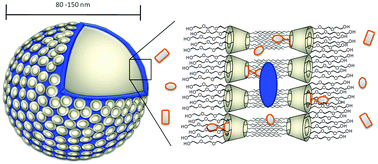Fluorescence quenching in β-cyclodextrin vesicles: membrane confinement and host–guest interactions†
Abstract
Fluorescent β-cyclodextrin vesicles (β-CDV) that display host cavities available for host–guest interactions at the vesicle surface were prepared by incorporation of the hydrophobic spirobifluorene-based dye 1 into the membrane of unilamellar vesicles. Fluorescence quenching of dye 1 was observed in the presence of different quenchers. Methyl viologen 2 does not quench dye 1 because it does not bind to β-CDV. 4-Nitrophenol 3 and 4-nitrophenol covalently connected to adamantane 4 quench the fluorescence of dye 1 in neutral solution, but by different mechanisms according to lifetime measurements. The quenching efficiency of 3 is pH dependent due to the presence of the phenolate form. Competition experiments with excess host and guest showed that 3 is likely to diffuse in and out of the membrane, while 4 forms an inclusion complex with β-CDV leading to close contact and efficient quenching. Our findings confirm that this dynamic supramolecular system is a versatile model to investigate quenching and recognition processes in bilayer membranes.

- This article is part of the themed collection: The 16th International Congress on Photobiology

 Please wait while we load your content...
Please wait while we load your content...